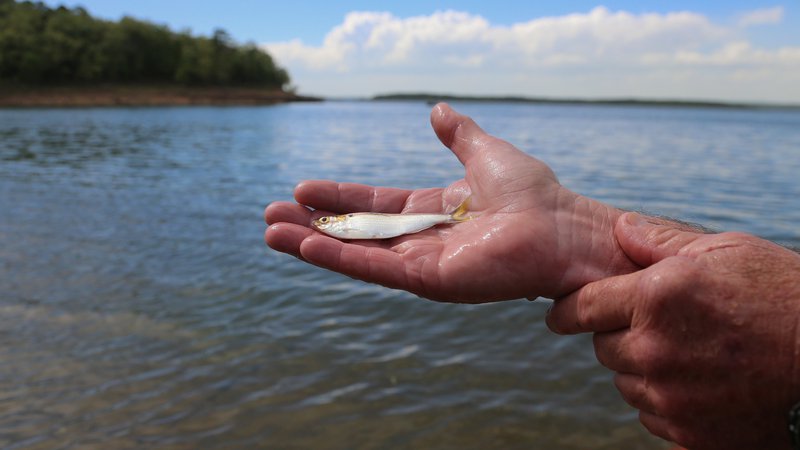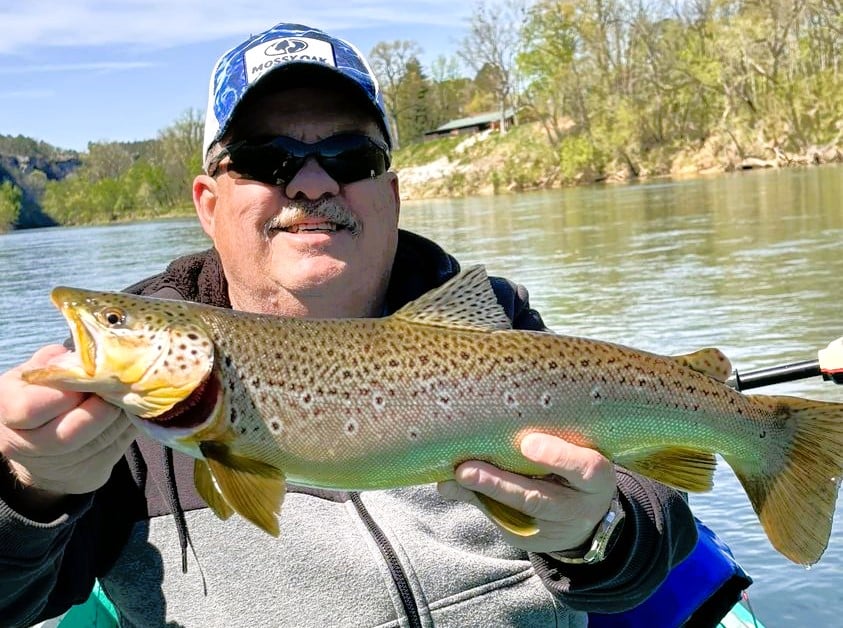High water and habitat come together for Greers Ferry fish
BY Jim Harris
ON 05-17-2017

May 17, 2017
Jim Harris
Managing Editor Arkansas Wildlife Magazine
Recent rainfall has elevated the water at Greer’s Ferry Lake a good 7-8 feet above its normal level. Recent electrofishing by Arkansas Game and Fish Commission personnel indicate improving numbers now for largemouth and smallmouth bass. And both AGFC biologists and anglers on the lake have noted a significant amount of threadfin shad in the upper and middle portions of the lake.
All of this accounts for the smiles among the AGFC Fisheries Division biologists when they discuss a turnaround of the bass population at Greers Ferry Lake and better opportunities for anglers now and in the future.
“The bottom line,” AGFC Fisheries Management biologist Matt Schroeder said of Greers Ferry Lake, “is the bass black population and smallmouth bass population are no longer declining and are starting to improve.”
The lake was more than 7 feet above the normal pool level on May 10, according to the Army Corps of Engineers. This means that water is getting back into buckbrush and trees and in cover, which is important for young fish to survive after the spawning season. High water also delivers more nutrients into the lake, which promotes better phytoplankton and zooplankton blooms, the base of the aquatic food chain. Plankton are an important food source for young black bass as well as other predator species before they convert to insects and prey fish. Important prey species such as threadfin shad are planktivores and feed on plankton their entire lives, Schroeder said.
High-water events at Greers Ferry Lake were also recorded in 2008, 2009 and 2011, and in 2008-09 there were good numbers of bass in the lake. Also in 2008-09, a significant amount of threadfin shad was available, providing a major food source for the largemouth and smallmouth bass.
However, as Schroeder notes, several factors may have led to a forage crash in 2013-14 – it is likely the predator population ate up much of the shad, and two consecutive harsh winters may have wiped out the rest. Threadfin shad will start dying in water temperatures below 45 degrees.
Nevertheless, without that food source, bass numbers as well as other sport fish such as crappie and walleye began to noticeably decline in Greers Ferry Lake.
“That’s just speculation, our best guess as to what caused it. We have nothing empirical as to why,” Schroeder said of the forage crash.
Last year, the AGFC began reintroducing threadfin shad in the lake. The project required importing thousands of the threadfin shad from Alabama to add to what the AGFG hatcheries could produce.
“All told, we had close to 600,000 shad,” Schroeder said. “We stocked 200,000 in the lake and then we raised another 400,000 in the [Greers Ferry Lake] nursery pond.
“The Joe Hogan Hatchery at Lonoke also purchased threadfin shad to use as brood fish in their first attempts at culturing the species. The Andrew Hulsey Hatchery at Hot Springs used brood fish obtained from Lake Hamilton. They were both successful in their efforts and provided over 150,000 of the fish that went into Greers.”
The AGFC has committed to a five-year plan to stock threadfin in Greers Ferry. “We are in the second year of the project and just completed our spring stockings in the nursery pond and lake the last week of April. The nursery pond crop is scheduled to be released into the lake in late June. The AGFC’s goal is to provide all of our threadfin stocking needs around the state through our hatchery system and not have to look to outside vendors,” Schroeder said.
Using the newest delivery of threadfin shad and allowing them to spawn, Schroeder said, the Fisheries Division is planning for up to a half-million shad that can be stocked in Greers Ferry Lake this year.
Apparently, they will be joining a large number of “cousins.” Observations from the biologists and reports received from anglers indicate that the shad added to the lake last year has remained abundant in multiple-size classes, something not seen in several years.
“We were out doing our sampling and saw huge schools of the threadfin shad, giant schools of them everywhere,” Schroeder said. “They’ve started to make a good rebound.”
That, in turn, has led to a bounce-back of the bass, if the electrofishing sampling the week of April 10 is an indication. Those numbers haven’t been analyzed yet, Schroeder said, but he’s confident it will show a trend in the right direction. Sampling from 2016 indicated that the black bass decline in the lake had ended and populations had stabilized, he said.
“And now we’ve got high water,” he added. “All of this is exactly what we need.
Sampling conducted by District 10 biologists at the lake indicate that overall relative abundance and the relative abundance of Age-1 largemouth bass were higher than they had been since 2011. This indicates that a stronger year class from the spawn of 2016 should be a major factor in the upcoming years, the biologists say. Meanwhile, smallmouth bass have had two banner years in terms of overall relative abundance and relative abundance of Age-1 samples, and this should be a major contributor to the fishery in the next few years. Continued efforts of threadfin shad stocking to provide forage for the expanding bass populations should make a big impact, the biologists say.
The AGFC’s threadfin shad isn’t going just to Greers Ferry Lake. Tommy Laird, hatchery manager at C.B. “Charlie” Craig State Fish Hatchery in Centerton, noted that while the majority goes to Greers Ferry Lake, other lakes receiving shad last year were Mallard Lake, Lower Lake Hogue, Lake Ashbaugh, Lake Monticello, Terre Noire Lake, Lake Columbia and Little South Fork Lake. This year, tentative plans call for shad to be stocked in Lake Maumelle, Lake Monticello, SWEPCO Lake, Lake Ashbaugh, Lake Bono, Crowley’s Ridge State Park Lake, Lower Lake Hogue and Mallard Lake.
“The key is, if the shad can carry over through the winter and grow into adults, it will have even more of an impact next year,” Laird said. “The key is carrying over brood stock and them spawning in the lake.”
Recent News

Arkansas Wildlife Weekly Fishing Report
Apr. 18, 2024
Subscribe to Our Weekly Newsletter E-mails
Don’t miss another issue. Sign up now to receive the AGFC Wildlife Weekly Newsletter in your mailbox every Wednesday afternoon (Waterfowl Reports are published weekly during waterfowl season and periodically outside the season). Fishing Reports arrive on Thursdays. Fill in the following fields and hit submit. Thanks, and welcome!

